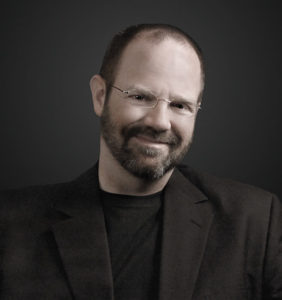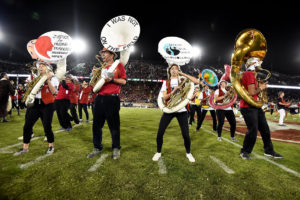Just a few short months after Stanford University lifted the marching band’s latest suspension, a traditional director— Russell Gavin—takes the realm of this student-led band to help turn around its notorious reputation.
 To recover from its infamous status within the marching arts community, the Leland Stanford Junior University Marching Band (LSJUMB) in California is entering a new era with the introduction of a professional band director in the dominantly student-run scatter band. Director Russell Gavin has an extensive history in music education and will use the skills he has developed to help lead the band to success.
To recover from its infamous status within the marching arts community, the Leland Stanford Junior University Marching Band (LSJUMB) in California is entering a new era with the introduction of a professional band director in the dominantly student-run scatter band. Director Russell Gavin has an extensive history in music education and will use the skills he has developed to help lead the band to success.
Halftime: What is your musical background?
Gavin: I got my Bachelor of Music Education from Auburn University in Alabama. I got my Master [of Music] in Euphonium Performance from the University of Notre Dame, then I taught high school. I got my doctorate from Florida State in wind conducting … and got the most amazing position as a music education professor at Baylor University.
In 2012, I was named corps director of the Blue Stars Drum and Bugle Corps. I had marched with the Blue Stars in the ’90s and served in a number of other positions.
I’ve had an exceptionally fortunate career.
 Halftime: Why did you take the job at Stanford?
Halftime: Why did you take the job at Stanford?
Gavin: When the band was suspended, … I looked into it and saw they were hiring a music director. I sat down and wrote a super stream-of-consciousness cover letter. … I clicked send, and they called within a week and got the ball rolling.
I have had a very traditional band director training. When this opportunity came up, I was looking for all the reasons not to take it, quite honestly, but all I found was a lot of miscommunication and opportunity.
I was inspired to take the job because of the opportunity I saw working at one of the most elite schools in the world, surrounded by the most elite students in the world, doing band. When put in that lens, it’s a pretty amazing opportunity. I figured I was the right person for it.
Halftime: How have your previous positions influenced your role in the LSJUMB?
At the end of the day, everyone wants to sound better. That’s true if I’m at the Blue Stars or Florida State or if I’m at Stanford.
Halftime: What is your role in the band and at the university?
Gavin: It’s a strange and special place with the amount of responsibility the students have. My role is to help and empower them. Being an advocate for the group, I’m here to work alongside them. I’m here to teach Stanford what it means to have a college band and how to appreciate and support a college band.
Halftime: What is unique about the LSJUMB?
Gavin: It’s more like a club than a college band, especially in the sense that there are no current requirements in terms of attendance.
[Also] the band is about 35% beginners. These brilliant young people come in and say, “Can I try trombone?” and the Stanford band says, “Yeah! And if that doesn’t work out, here’s an alto sax! Let’s have some fun!”
It’s different, but that’s OK, and I think it’s actually kind of beautiful. I think the Stanford band can exist as something very outside the norm but still [something] very important and very cool.
Halftime: How has the Stanford band restructured since your arrival?
Gavin: The students who were in place are the ones who went through the process … to lift the restrictions before I got here. The students themselves have been the change agent. They’re dictating what kind of a group they want to become, and I am here supporting that vision.
In an ideal world, I really help guide them in musical conversations. They’ve been arranging their own music, and having someone in the room to give professional feedback is really important.
Halftime: What is your top priority in initiating change this season?
Gavin: We should never forget [that] when we put on funny-looking outfits and run around [during] a football game, if at any point, we find ourselves sacrificing the dignity of a young person for this activity, we have been led astray. [I want to] keep the group unique in the ways that make people love it and reduce the number of people who hate it.
[I’m] making sure the students know I’m here to work cooperatively with them. I’ve really enjoyed the students and felt like the [band] administration was all set up to really experiment and explore some real change. In some minds, they’ve had a negative reputation for so long. [I’m] convincing people to give the group a chance in evolving into the next chapter of its life. When I explain to people the beauty of its differences, people open their minds a little bit. With my guidance, the essence of the group will remain the same.
Halftime: What are your hopes and goals for the future of the band?
Gavin: I want us to play the national anthem better every game, … having that moment of our performance experience be something that we try to refine in quality of music.
[I want to] get the group a little larger and get people to understand what a positive and amazing contribution the band is to Stanford, to the Bay Area, and to music education. This group performs at the Special Olympics and at elementary schools and does all sorts of charity events.
I think the definition of a successful experience is going to be different for every group. [At Stanford] we hope to get better musical training and have the consistency of a person in the room from year to year to remind everyone what the vision of the group is.
Halftime: What advice do you have for other directors?
Gavin: You’ve got to learn your culture and your audience and your students, … really getting an understanding of why students are walking in the door and using that as a stepping-off point. It’s all about the community and the human beings around you. I encourage people to remember that we are a student-centered community, and our mission should be to give the students the best possible experience.


